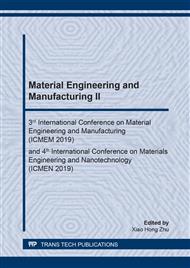[1]
Gao W, Zhang Y, Ramanujan D, Ramani K, Chen Y, Williams CB, Wang CCL, et al. (2015) The status, challenges, and future of additive manufacturing in engineering. Computer-Aided Design,69:65-89.
DOI: 10.1016/j.cad.2015.04.001
Google Scholar
[2]
Kempen K, Vrancken B, Buls S, Thijs L, Humbeeck JV, Kruth JP. (2014) Selective Laser Melting of Crack-Free High Density M2 High Speed Steel Parts by Baseplate Preheating. Journal of Manufacturing Science & Engineering,136:1-6.
DOI: 10.1115/1.4028513
Google Scholar
[3]
Liu H, Sparks T, Liou F. Residual Stress and Deformation Modelling for Metal Additive Manufacturing Processes: Proceedings of the World Congress on Mechanical, Chemical, and Material Engineering (MCM 2015), Barcelona, Spain[C].
Google Scholar
[4]
Szost BA, Terzi S, Martina F, Boisselier D, Prytuliak A, Pirling T, Hofmann M, et al. (2016) A comparative study of additive manufacturing techniques: Residual stress and microstructural analysis of CLAD and WAAM printed Ti–6Al–4V components. Materials & Design,89:559-567.
DOI: 10.1016/j.matdes.2015.09.115
Google Scholar
[5]
Zhang J, Wang X, Paddea S, Zhang X. (2016) Fatigue crack propagation behaviour in wire+arc additive manufactured Ti‐6Al‐4V: Effects of microstructure and residual stress. Materials & Design,90:551-561.
DOI: 10.1016/j.matdes.2015.10.141
Google Scholar
[6]
Parry L, Ashcroft IA, Wildman RD. (2016) Understanding the effect of laser scan strategy on residual stress in selective laser melting through thermo-mechanical simulation. Additive Manufacturing,12:1-15.
DOI: 10.1016/j.addma.2016.05.014
Google Scholar
[7]
Lindgren LE, Lundbäck A, Fisk M, Pederson R, Andersson J. (2016) Simulation of additive manufacturing using coupled constitutive and microstructure models. Additive Manufacturing,12:144-158.
DOI: 10.1016/j.addma.2016.05.005
Google Scholar
[8]
Vastola G, Zhang G, Pei QX, Zhang YW. (2016) Controlling of residual stress in additive manufacturing of Ti6Al4V by finite element modeling. Additive Manufacturing,12:231-239.
DOI: 10.1016/j.addma.2016.05.010
Google Scholar
[9]
Marimuthu S, Clark D, Allen J, Kamara AM, Mativenga P, Li L, Scudamore R. (2013) Finite element modelling of substrate thermal distortion in direct laser additive manufacture of an aero-engine component. Proceedings of Institution of Mechanical Engineers Part C Journal of Mechanical Engineering Science,227:1987-1999.
DOI: 10.1177/0954406212470363
Google Scholar
[10]
Heigel JC, Michaleris P, Reutzel EW. (2015) Thermo-mechanical model development and validation of directed energy deposition additive manufacturing of Ti–6Al–4V. Additive Manufacturing,5:9-19.
DOI: 10.1016/j.addma.2014.10.003
Google Scholar
[11]
Boyer R, Welsch G, Collings E. (1994) Materials Properties Hand Book: Titanium Alloys.
Google Scholar
[12]
Wu J, Wang L, An X. (2017) Numerical analysis of residual stress evolution of AlSi10Mg manufactured by selective laser melting. Optik - International Journal for Light and Electron Optics.
DOI: 10.1016/j.ijleo.2017.02.060
Google Scholar


